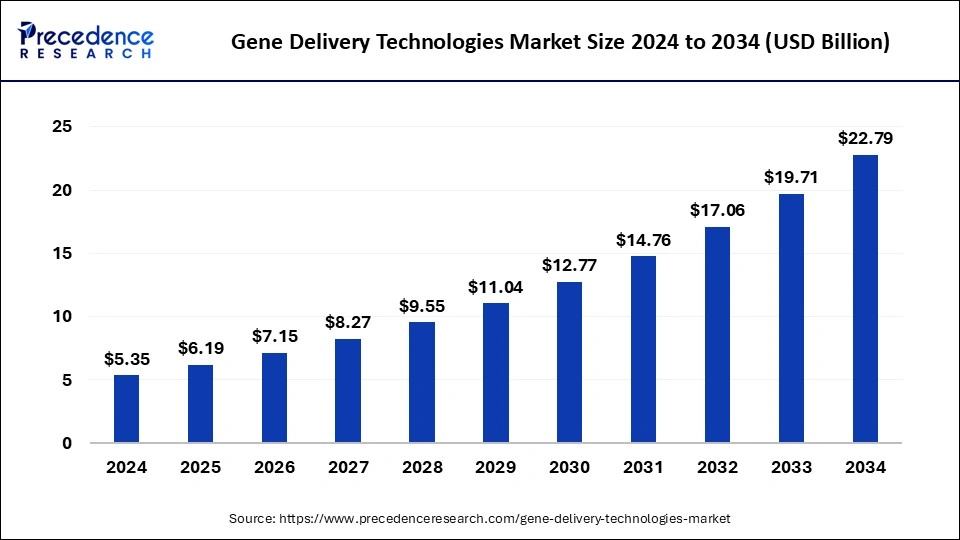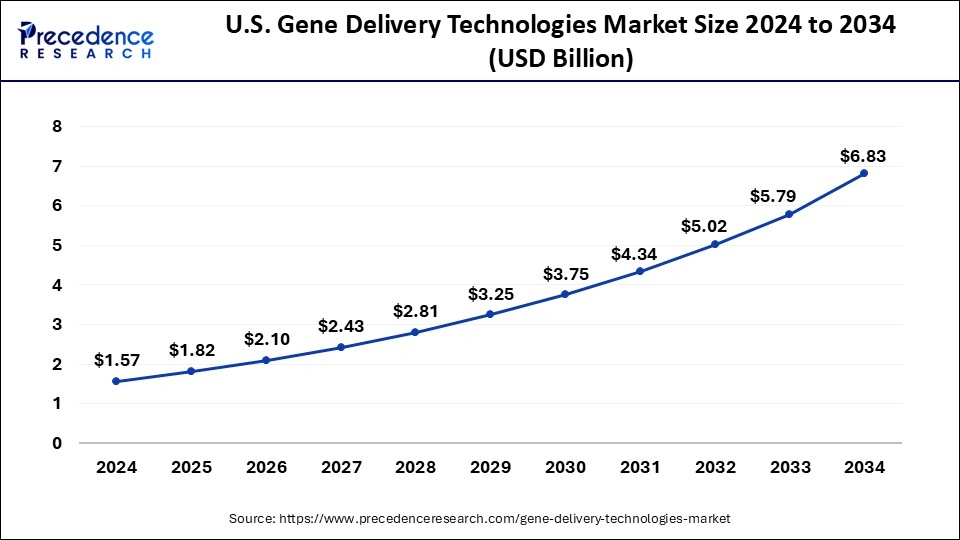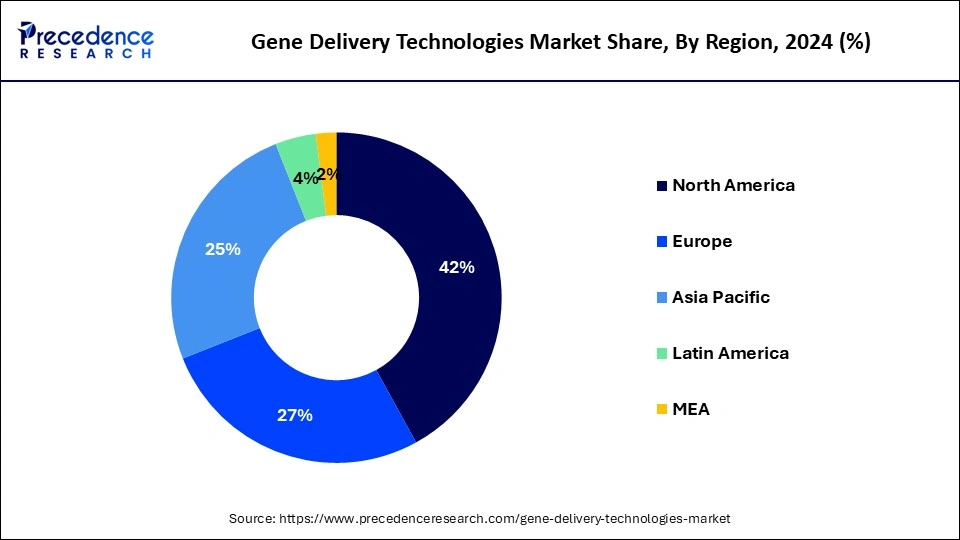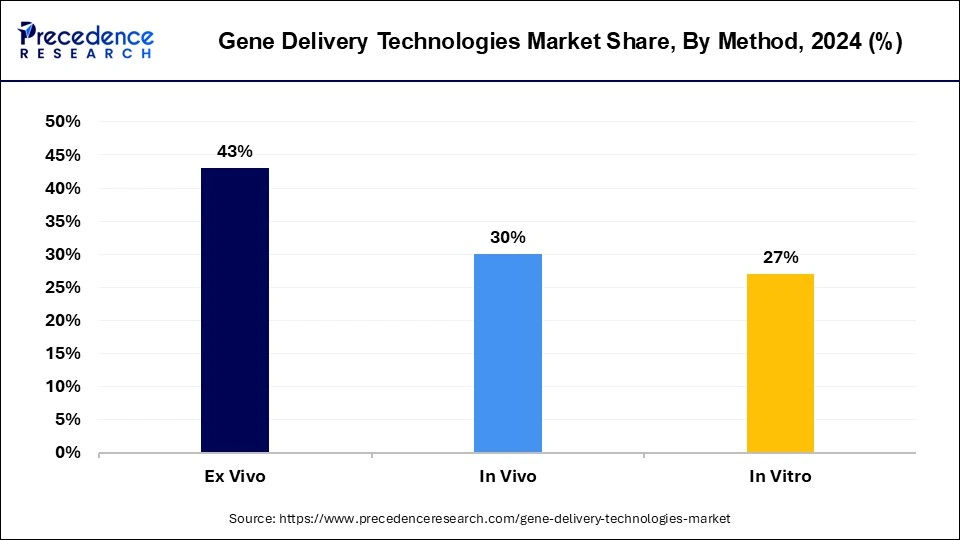February 2025
The global gene delivery technologies market size is accounted at USD 6.19 billion in 2025 and is forecasted to hit around USD 22.79 billion by 2034, representing a CAGR of 15.60% from 2025 to 2034. The North America market size was estimated at USD 2.25 billion in 2024 and is expanding at a CAGR of 15.58% during the forecast period. The market sizing and forecasts are revenue-based (USD Million/Billion), with 2024 as the base year.
The global gene delivery technologies market size was calculated at USD 5.35 billion in 2024 and is predicted to increase from USD 6.19 billion in 2025 to approximately USD 22.79 billion by 2034, expanding at a CAGR of 15.60% from 2025 to 2034.

The U.S. gene delivery technologies market size was exhibited at USD 1.57 billion in 2024 and is projected to be worth around USD 6.83 billion by 2034, growing at a CAGR of 15.84% from 2025 to 2034.

North America dominated the market in 2024, the region is expected to continue to grow during the forecast period. The massive growth of gene delivery technologies market in North America is attributed to the rapid adoption of technologies in the biotechnology and healthcare sector. The prominent academic research, the presence of multiple major biotechnology companies and the region’s overall position at research and development activities supplement the market’s growth.
The market in North America is also supported by the regulatory frameworks that facilitate clinical trials. The rising emphasis on commercializing gene therapies along with the willingness of patients to spend on gene therapies promotes the growth of the market in North America.

On the other hand, Asia Pacific is expected to witness the fastest growth during the forecast period. Countries in India, China, Japan and South Korea are witnessing rapid growth in the healthcare industry. Along with this, the rising investments in advanced gene therapies are expected to promote the growth of the market in the Asia Pacific. The rising focus on research and development activities, rising prevalence of genetic disorders and the overall advancements in the biotechnology sector contribute to the growth of the market in Asia Pacific.
The government’s support also supplements the growth of the market in Asia Pacific. The South Korean government has made significant strides in gene delivery technologies, the government is also actively promoting gene therapies along with the implementation of several healthcare policies. All these elements together fuel the growth of the gene delivery technologies market in the Asia Pacific.
The gene delivery technologies market is an industry or segment that focuses on the development, manufacturing, and commercialization of technologies or techniques used for delivering therapeutic genes. The global gene delivery technologies market offers a wide range of approaches and platforms designed to safely and effectively introduce genetic material into living organisms.
Such technologies are crucial for gene therapy. Gene therapies refer to a segment of medicinal science that deals with treating or preventing multiple diseases by silencing or modifying patients’ cells. The global market for gene delivery technologies includes numerous approaches, including various vectors, applications, and methods. At the same time, the rising understanding of molecular biology is observed to offer a bright future for the gene delivery technologies market.
The rising prevalence of chronic diseases, the accelerating pace of technological advancement, and the increasing demand for targeted therapeutics are just a few of the significant factors driving the global market for gene-delivery technologies. Advanced physical gene delivery techniques like electroporation have all seen substantial research due to advances in physics and nanotechnology. These methods are becoming more popular because of their benefits, briefness, and nontoxicity. These elements are projected to increase the demand for the products present in this market and consequently encourage operational players' organic revenue growth.
| Report Coverage | Details |
| Market Size in 2025 | USD 6.19 Billion |
| Market Size by 2034 | USD 22.79 Billion |
| Growth Rate from 2025 to 2034 | CAGR of 15.60% |
| Largest Market | North America |
| Base Year | 2024 |
| Forecast Period | 2025 to 2034 |
| Segments Covered | Delivery System, Application, and Method |
| Regions Covered | North America, Europe, Asia-Pacific, Latin America, and Middle East & Africa |
Improvements in the gene delivery systems
Improvements in gene delivery systems are observed to act as a significant driver for the market. Advancements in gene delivery systems enable more effective delivery of therapeutic genes to target cells or tissues. Such improvements offer expanded treatment scope by increasing the market size for gene delivery technologies.
Moreover, the improvements in the gene delivery systems assure improved safety and increased scalability; all these factors collectively boost the adoption and commercialization of gene delivery technologies.
High cost of treatment
Gene therapies are widely used for treating multiple inherited disorders. The high cost of such therapies limits patients to enroll themselves for the healthcare services associated with gene therapies. Usually, the high research and production cost of therapies creates challenges for patients.
The high cost of production along with the research activities affects the investments in the industry. The high cost of therapies puts a strain on healthcare budgets, especially in publicly funded healthcare systems. Governments and healthcare organizations may be hesitant to allocate substantial resources to gene delivery technologies, considering the long-term sustainability of funding such expensive treatments.
Deployment of nanotechnology in gene delivery technology
Nanotechnology offers precise control over the delivery of therapeutic genes to specific cells and organs. Nanoparticles achieved by nanotechnology can be engineered to have specific surface properties that allow them to interact with target cells or organs. The deployment of nanotechnology provides stability and protection to therapeutic genes during the delivery process, which aims to improve the overall efficacy of the treatment.
In addition, the deployment of nanotechnology in gene delivery provides significant advantages in terms of combination and controlled release. With the rising efforts to bring versatility in gene delivery technologies, the penetration of nanotechnology is observed to serve multiple opportunities for market players.
The viral gene delivery system segment is expected to dominate the market during the forecast period. Lentiviruses, retroviruses, and adenoviruses are used as viral gene-delivery vectors. Viral gene delivery systems are made up of viruses that have been modified to be replication-deficient; these viruses were made sterile through reengineering and can deliver the genes to the cells for expression. Viral gene delivery employs lentiviruses, retroviruses, and adenoviruses.
Viral vectors are widely utilized as a gene delivery system; they use modified viruses to deliver therapeutic genes. The rising demand for efficient gene transfer and long-term gene expression will promote the segment's growth during the forecast period.
Non-viral vectors delivery system is another lucrative segment of the market that delivers therapeutics without utilizing viruses. The advantages, such as low immunogenicity, ease of production, and ability to deliver larger DNA payloads via non-viral delivery systems, support the growth of the segment.
The gene therapy segment acquired the largest revenue share of the market in 2023; the segment is expected to hold the largest share during the forecast period. The rapid adoption of gene therapies across the globe promotes the segment’s development. This segment includes applications such as treating genetic diseases, cancer gene therapy, and infectious diseases. The rising demand for precise therapeutic dosages for conditions such as cancer supports the development of the gene therapy application segment.
The research segment is another attractive segment in the market for application purposes; gene delivery technologies serve as an ideal tool for research laboratories. Researchers utilize gene delivery technologies for expression analysis, gene knockout studies, and functional genomics.
The ex-vivo method segment had the largest market share in 2024; the segment will continue to grow at a significant rate. The ex-vivo method segment of the gene delivery technologies market allows the delivery of genes into cells or tissues before re-implantation into the patient.

The ex-vivo methods have been extensively used in various applications, including gene therapy and even stem cell therapy. The requirement for precise genetic modification and manipulation of cells from the industry to approach an effective treatment pattern highlights the significance of the ex-vivo method segment.
By Mode
By Application
By Method
By Geography
For inquiries regarding discounts, bulk purchases, or customization requests, please contact us at sales@precedenceresearch.com
No cookie-cutter, only authentic analysis – take the 1st step to become a Precedence Research client
February 2025
January 2025
February 2025
November 2024